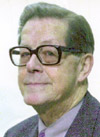
in recognition of his important contributions to auroral and magnetospheric physics and his leading role in initiating and supporting space research projects both nationally and internationally
In 1957, Professor Bengt Hultqvist became the first director of Kiruna Geophysical Observatory which was Sweden's main contribution to the IGY. He developed this institute, which in 1987 became the Swedish Institute of Space Physics (IRF), into one of the leading European space research institutes. His institute has made many successful experiments on ESRO/ESA satellites and great contributions to magnetospheric and, in particular, auroral particle physics.
Bengt Hultqvist has played a leading role in the Swedish space research program as well as in international space research efforts. In the early 1960s, he became involved in the creation of the European Space Research Committee (ESRO). He successfully proposed the establishment of the European rocket range ESRANGE and was one of the founding fathers of the European Incoherent Scatter Radar EISCAT. He was the initiator of the highly successful Swedish satellites Viking and Freja, and was largely responsible for the creation of ESA's Solar-Terrestrial Cornerstone with the SOHO and Cluster missions.
After retirement, Bengt Hultqvist became one of the directors of the International Space Studies Institute (ISSI) and led the production of authoritative books on magnetospheric physics. He received many honors, among them the King's medal in 1991 and the Berzelius gold medal of the Royal Swedish Academy of Sciences.